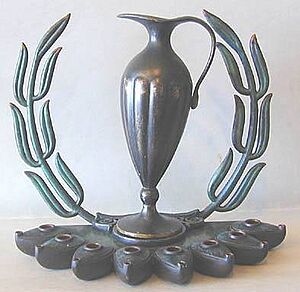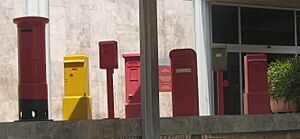Eretz Israel Museum facts for kids
The Eretz Israel Museum, also called Muza, is a cool museum in Tel Aviv, Israel. It's all about history and archaeology. The museum opened in 1953.
It has many amazing things on display. You can see ancient tools, old art, and items from different cultures. These are shown in special buildings called pavilions. Each pavilion focuses on a different topic, like glass, pottery, or coins. The museum even has a planetarium where you can learn about space!
In the "Man and His Work" area, you can watch live shows. People demonstrate old ways of weaving cloth or making pottery. They also show how ancient people ground grain and baked bread. There's also an archaeological dig site called Tel Qasile right on the museum grounds. Scientists have found 12 different layers of history there!
Contents
Exploring Ancient Times: Archaeology at Muza
Copper Production: From Mines to Metal
The Nechushtan pavilion teaches you about how copper was made long ago. This happened in a place called Timna in the southern Negev desert. People made copper there during the Stone Age, Bronze Age, and Iron Age.
Inside the pavilion, you can see a recreated mine. It shows how ancient miners worked. You'll also see old furnaces used for melting copper. There are even items found from an Egyptian-Midianite mining temple at Timna.
The recreated mine shows tools like stone hammers and copper chisels. You can see the marks these tools left on the rocks.
Ancient Smelting Furnaces
The museum displays four types of furnaces used to melt copper:
- A bowl furnace from the Stone Age (about 4,000 years BCE).
- A domed furnace from the Late Bronze Age (around 1,400-1,300 BCE).
- A real Late Bronze Age furnace (from the 12th century BCE).
- A tall shaft furnace from the Iron Age (around 10th century BCE).
The Midianite Temple Story
Around 1,400 BCE, Egyptian pharaohs sent groups to Timna to mine copper. They worked with skilled metalworkers from the Land of Midian. They kept mining copper until the early 12th century BCE.
This pavilion has a model of a Midianite temple. One special item is a copper snake with a gold head. It was found in the Midianite shrine. This reminds people of the biblical story of Nehushtan, the bronze snake Moses made.
Glass Through the Ages
The Glass pavilion shows many ancient glass items. The exhibit is split into three parts. Each part covers a different time in glassmaking history.
- Pre-blown glass: From the Late Bronze Age to the Hellenistic period (15th-1st centuries BCE). This was before people learned to blow glass.
- Blown glass of Roman and Byzantine times: From the 1st to 7th centuries CE. This is when glass blowing became popular.
- Blown glass of the Islamic period: From the 7th to 15th centuries CE.
Two very rare glass items are on display. One is a delicate drinking horn called a "rhyton". The other is "Ennion's Blue Jug". It has the signature of its famous maker, who lived in the 1st century CE.
Parts of a glass furnace from the 13th century CE were found near a Crusader castle. This castle was in a place called Sommelaria, north of Acre.
The museum also has a special gold-glass panel from the Byzantine period. It's from the late 6th or early 7th century. This panel was found in a place called Caesarea.
Cultures and Traditions: Ethnography and Folklore
This part of the museum shows items related to Judaica. These are things made by Jewish people living in different parts of the world. It also includes items made in the Land of Israel between 1880 and 1967.
Money Matters: Numismatics
The Kadman Numismatic section is all about money! It shows how people paid for things in the country. You can see early forms of payment before coins were invented. Then, it takes you through all the different coins and money used throughout history, right up to today.
Sending Mail: Postal History and Philately
The Alexander Museum of Postal History and Philately tells the story of mail service. It covers the Land of Israel from the mid-15th century until 1948. That's when the state of Israel was founded.
You can see old envelopes, letters, and photos. There are also posters, mailboxes, and telephones. They even have a mail truck from 1949! The philatelic wing shows off valuable and rare stamps.
More to Explore
- List of Israeli museums
- Art in Tel Aviv
See also
 In Spanish: Museo Eretz Israel para niños
In Spanish: Museo Eretz Israel para niños





